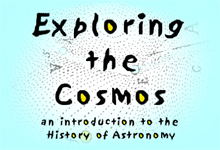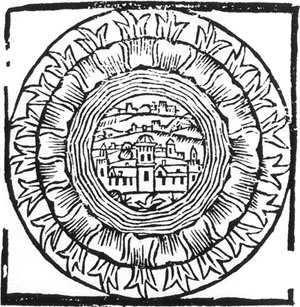

Department of History
University of California, Irvine
Instructor: Dr. Barbara J. Becker
![]()
Week 2. The Copernican Revolution.
excerpts from
The pryncyples of astronamye the whiche diligently
perscrutyd is
in maners pronosticacyon to the worldes end
(1542?)
by Andrew Boorde (1490?-1549)
![]()
The Preface It is greatly to be lamented that all men almost do now consider the seven liberal sciences to be of no use, especially Astronomy the which, of truth, is a necessary science and does illucidate all other sciences: not only the liberal sciences as grammar, rhetoric, logic, arithmetic, geometry, and music, but also it is an introduction to philosophy, physic [medicine], and divinity. It is not unknown that philosophy consists in natural philosophy and moral philosophy, to the naturality and morality of the which no man can attain without Astronomy. Also Astronomy does illucidate physic, for Hippocrates says, "He is a blind physician the which does not know Astronomy." Also Astronomy does give knowledge to divinity as it does plainly appear in the first chapter of the Genesis, and divers other places wherefor David does say, "The heavens show the glory of God, the firmament shows the works of God." I, considering these premises with the great utility of the aforesaid things do make this book to animate all men to have a respect to it and to study it to laud it to praise God in his works and where I have omitted and left out many matters pertaining to this book, let them look in a book named the Introduction of Knowledge, a book of my making the which is aprinting at old Robert Copland's the eldest printer of England the which does print these present prognostications. Finis.
| |
The Table of contents of this book follow The first chapter does show the names of twelve signs and of the seven planets. And what the zodiac [is] and how many minutes a degree does contain. The second chapter does show what signs be movable, and what signs be not movable and which be common and which be masculine signs and which be feminine and of the triplicity of them. [Each zodiac sign was part of a trio of signs separated by 120°.] The third chapter does show in what members or places in man and signs have their dominion and how no man ought to be let blood when the moon is in the sign where the sign has dominion and also what operation the signs be of when the moon is in there. The fourth chapter does show of the fortitudes of the planets and what influence they do give to us. The fifth chapter does show the natural disposition of the moon when she is in any of the twelve signs. The sixth chapter does show of the nature of all the twelve signs and what influence they have in man. And what fortitudes the planets have in the signs with the names of the aspects [the relative positions of the planets and fixed stars to one another]. The seventh chapter does show the natural dispositions of the planets. And what operation they have on man's body. The eighth chapter does show of the five aspects [conjunction (0° separation), sextile (60° separation), quartile (90° separation), trine (120° separation), opposition (180° separation)], and of their operation. The ninth chapter does show of the mutation of the Air when any rain, wind, weather, frost and cold should be by the course of the signs and planets. The tenth chapter does show the [influence] of the aspect of the moon and other planets and what days be good and what days be not, etc. The eleventh chapter does show of phlebotomy or letting of blood. The twelfth chapter does show how when and what time a physician should minister medicines. The thirteenth chapter does show of sowing of seeds and planting of trees and setting of herbs. 
|
|
Chapter I. The first chapter does treat of the names of the planets and also of the names of the signs and what the zodiac is and how many degrees be in the zodiac, and how many minutes a degree does contain. The names of the seven planets be these: Saturn, Jupiter, Mars, the Sun, Venus, Mercury, and the Moon. These be the names of the twelve signes: Aries, Taurus, Gemini, Cancer, Leo, Virgo, Libra, Scorpio, Sagitarrius, Capricorn, Aquarius, and Pisces. The zodiac is the Circle in the which the twelve signs be in, named the circle of beasts, or the oblique circle. It may be called well the circle of beasts for the signs within the circle have or be of that disposition of the beasts of whom they do take their names or be likened unto. As Aires is likened to the Wedder [castrated lamb] or Ram, Taurus is like to the Bull, Gemini is likened to the two children born at a birthing. Cancer is likened to the Crab or Crawfish. Leo is likened to the Lion. Virgo is likened to a Maid. Libra is likened to a pair of balances. Scorpio is likened to a venomous worm named a Scorpion. Sagitarrius is likened to a monstrous archer or shooter the which is like a man from the middle upward and like a four-footed beast from the middle downward. Capricorn is likened to the water[-goat?]. Pisces is likened to fishes. These signs give influence to us by like operation as the beasts be of nature. Every one of these signs is divided in sixty degrees. And every degree does contain sixty minutes, so that in the zodiac is three hundred six[ty] degrees....
|
|
Chapter III. The third chapter does show in what members or places in man the signs have their dominion or power. And how no man ought to be let blood when the moon is in the sign where the sign has dominion. And also what operation the signs be of when the moon is in them. The twelve signs have dominion upon the members of every man. For Aries beholds the head. Taurus, the neck. Gemini, the arms and hands. Cancer, the breast. Leo the heart. Virgo, the belly. Libra, the reins [kidneys and loins] and buttocks. Scorpio, the secret places of man. Sagittarius, the thighs. Capricorn, the knees. Aquarius, the legs. Pisces the feet. Let every man be wary no phlebotomist or letter of blood, nor no manner of surgeon do touch him in opening any vein or do make any incision or cutting when the moon is in any sign where the sign has any dominion or does reign. Also when the moon is in a movable sign, it is good to take a vomit [an emetic, or preparation designed to maintain good health by clearing out the digestive system] and good to take a journey or to go about any manner of business or to begin any matter pertaining to worldly policy. When the moon is in a fixed sign it is good to make foundations of houses or walls, good to build & to re-edify & to go about stable works. When the moon is in a common sign it is not good to make no marriage nor to marry nor to make no bargain without record and sure writing, nor good for sick men, & signifies much in stability.
|
|